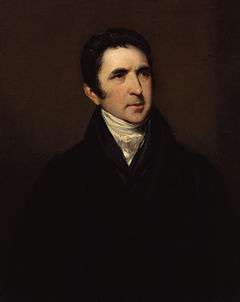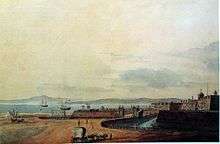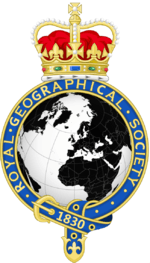Sir John Barrow, 1st Baronet
Sir John Barrow, 1st Baronet, FRS FRGS FSA (19 June 1764 – 23 November 1848) was an English civil servant, geographer, linguist and writer.
Sir John Barrow FRS FRGS FSA | |
|---|---|
 Barrow around 1810 | |
| Second Secretary to the Admiralty | |
| In office 22 May 1804 – 28 April 1845 | |
| Preceded by | Benjamin Tucker |
| Succeeded by | William Baillie-Hamilton |
| Personal details | |
| Born | 19 June 1764 Dragley Beck, Ulverston, Lancashire, England |
| Died | 23 November 1848 (aged 84) London, Middlesex, England |
| Spouse(s) | |
| Children | Sir George Barrow, Peter Barrow |
| Occupation | Geographer, linguist, writer |
Early life
Barrow was born the only child of Roger Barrow, a tanner in the village of Dragley Beck, in the parish of Ulverston, Lancashire.[1] He was schooled at Town Bank grammar school, Ulverston, but left at age 13 to found a Sunday school for the poor.
Barrow was employed as superintending clerk of an iron foundry at Liverpool. At only 16, he went on a whaling expedition to Greenland. By his twenties, he was teaching mathematics, in which he had always excelled, at a private school in Greenwich.[2][3]
China
Barrow taught mathematics to the son of Sir George Leonard Staunton; through Staunton's interest, he was attached on the first British embassy to China from 1792 to 1794 as comptroller of the household to Lord Macartney. He soon acquired a good knowledge of the Chinese language, on which he subsequently contributed articles to the Quarterly Review; and the account of the embassy published by Sir George Staunton records many of Barrow's valuable contributions to literature and science connected with China.[2]
Barrow ceased to be officially connected with Chinese affairs after the return of the embassy in 1794, but he always took much interest in them, and on critical occasions was frequently consulted by the British government.[2]
Some historians attribute the 'stagnation thesis' to Barrow; that China was an extremely civilized nation that was in a process of decay by the time of European contact.[4]
South Africa

In 1797, Barrow accompanied Lord Macartney as private secretary in his important and delicate mission to settle the government of the newly acquired colony of the Cape of Good Hope. Barrow was entrusted with the task of reconciling the Boer settlers and the native Black population and of reporting on the country in the interior. In the course of the trip, he visited all parts of the colony; when he returned, he was appointed auditor-general of public accounts. He then decided to settle in South Africa, married, and bought a house in 1800 in Cape Town. However, the surrender of the colony at the peace of Amiens (1802) upset this plan.
During his travels through South Africa, Barrow compiled copious notes and sketches of the countryside that he was traversing. The outcome of his journeys was a map which, despite its numerous errors, was the first published modern map of the southern parts of the Cape Colony.[5] Barrow's descriptions of South Africa greatly influenced Europeans' understanding of South Africa and its peoples.[4] William John Burchell (1781–1863) was particularly scathing: "As to the miserable thing called a map, which has been prefixed to Mr. Barrow’s quarto, I perfectly agree with Professor Lichtenstein, that it is so defective that it can seldom be found of any use."
Career in the Admiralty
Barrow returned to Britain in 1804 and was appointed Second Secretary to the Admiralty by Viscount Melville, a post which he held for forty years[2] – apart from a short period in 1806–1807 when there was a Whig government in power.[6] Lord Grey took office as Prime Minister in 1830, and Barrow was especially requested to remain in his post, starting the principle that senior civil servants stay in office on change of government and serve in a non-partisan manner. Indeed, it was during his occupancy of the post that it was renamed Permanent Secretary. Barrow enjoyed the esteem and confidence of all the eleven chief lords who successively presided at the Admiralty board during that period, and more especially of King William IV while lord high admiral, who honoured him with tokens of his personal regard.[2]
In his position at the Admiralty, Barrow was a great promoter of Arctic voyages of discovery, including those of John Ross, William Edward Parry, James Clark Ross and John Franklin. The Barrow Strait in the Canadian Arctic as well as Point Barrow and the city of Barrow in Alaska are named after him. He is reputed to have been the initial proposer of Saint Helena as the new place of exile for Napoleon Bonaparte following the Battle of Waterloo in 1815.[7] Barrow was a fellow of the Royal Society and received the degree of LL.D from the University of Edinburgh in 1821. A baronetcy was conferred on him by Sir Robert Peel in 1835.[8] He was also a member of the Raleigh Club, a forerunner of the Royal Geographical Society.[2]
Retirement and legacy
Barrow retired from public life in 1845 and devoted himself to writing a history of the modern Arctic voyages of discovery (1846), as well as his autobiography, published in 1847.[2] He died suddenly on 23 November 1848.[2] The Sir John Barrow monument was built in his honour on Hoad Hill overlooking his home town of Ulverston in 1850, though locally it is more commonly called Hoad Monument.[9] Mount Barrow and Barrow Island in Australia are believed to have been named after him.[10]
Barrow's legacy has been met with a mixed analysis. Some historians regard Barrow as an instrument of imperialism who portrayed Africa as a resource rich land devoid of any human or civilized elements.[11] Other historians consider Barrow to have promoted humanitarianism and rights for South Africans.[4]
Private life
Barrow married Anna Maria Truter (1777–1857), a botanical artist from the Cape, in South Africa on 26 August 1799.[12] The couple had four sons and two daughters, one of whom, Johanna, married the artist Robert Batty.[13] His son George succeeded to his title.
Bibliography
Besides 95 articles in the Quarterly Review,[3] Barrow published among other works:[2]
- Barrow, John (1792). A Description of Pocket and Magazine Cases of Mathematical Drawing Instruments, in which is explained the Use of each Instrument, and particularly, of the Sector and plain Scale, in the Solutions of a variety of Problems; likewise the Description, Construction, and Use of Gunter's Scale. London: J & W Watkins.
- — (1804). Travels in China, Containing Descriptions, Observations, And Comparison, Made And Collected in the Course of a Short Residence at the Imperial Palace of Yuen-Min-Yuen. London: T. Cadell And W. Davies. Retrieved 15 August 2009.
- — (1806). A Voyage to Cochinchina in the Years 1792 and 1793. London: T. Cadell And W. Davies. Retrieved 18 November 2016.
- — (1806). Travels into The Interior of Southern Africa. London: T. Cadell And W. Davies. Retrieved 15 August 2009.
- — (1807). Some Account of the Public Life, And A Selection From The Unpublished Writings, of The Earl of McCartney. London: T. Cadell And W. Davies. Retrieved 15 August 2009.
- — (1818). A Chronological History of Voyages into The Arctic Regions. London: John Murray. Retrieved 15 August 2009.
- The Eventful History of the Mutiny and Piratical Seizure of H.M.S. Bounty: (1831) Its Cause and Consequences. John Murray. 1831.
- — (1843). The life, voyages, and exploits of Admiral Sir Francis Drake : with numerous original letters from him and the Lord High Admiral to the Queen and great officers of state. London: John Murray.
- — (1838). The Life of Richard Earl Howe, K.G., Admiral of the Fleet, And General of Marines. London: John Murray. Retrieved 15 August 2009.[14]
- An Auto-Biographical Memoir of Sir John Barrow, Bart, Late of the Admiralty. Including Reflections, Observations, and Reminiscences at Home and Abroad, from Early Life to Advanced Age; Murray, 1847 (reissued by Cambridge University Press, 2009; ISBN 978-1-108-00470-1)
- — (1839). The Life of George Lord Anson, Admiral of The Fleet; Vice-Admiral of Great Britain; And First Lord Commissioner of the Admiralty, Previous To, And During, The Seven-Years' War. London: John Murray. Retrieved 15 August 2009.
- — (1840). The Life of Peter The Great (1908 ed.). London: John Murray. Retrieved 15 August 2009.
- — (1845). A Description of Pitcairn's Island And Its Inhabitants (Harper's Stereotype Edition, 1845). New York: Harper & Brothers. Retrieved 15 August 2009.
- — (1846). Voyages of Discovery And Research Within The Arctic Regions, From The Year 1818 to the Present Time. London: John Murray. Retrieved 15 August 2009.
- Life & Correspondence of Admiral Sir William Sidney Smith G.C.B. – London: Richard Bentley, 1848 (See William Sidney Smith.)
- — (1848). Sketches of the Royal Society And Royal Society Club. London: John Murray. Retrieved 15 August 2009.
- Staunton, George Thomas; John Barrow (1856). Memoirs of the Chief Incidents of the Public Life of Sir George Thomas Staunton, Bart. London: L. Booth. Retrieved 15 August 2009.
| Library resources about Sir John Barrow, 1st Baronet |
| By Sir John Barrow, 1st Baronet |
|---|
He was also the author of several valuable contributions to the seventh edition of the Encyclopædia Britannica.
Other reading
- Barrow's Boys – Fergus Fleming (1998) "For 30 years beginning 1816, the British Admiralty's John Barrow and his elite team charted large areas of the Arctic, discovered the North Magnetic Pole, were the first to see volcanoes in the Antarctic, crossed the Sahara to find Timbuktu and the mouth of the Niger – John Ross, John Franklin, William Edward Parry and others."[15]
See also
Notes
- Prior to 1 April 1974 Ulverston was in Lancashire
- Anonymous 1911.
- "Sir John Barrow 1764–1848". Ulverston Town Council. Retrieved 31 July 2016.
- Huigens, Siegfriend (2007). Verkenningen van Zuid-Afrika: achttiende-eeuwse reizigers aan de Kaap. Walburg Pers. p. 139.
- Standard Encyclopaedia of Southern Africa vol 2 (1970)
- Fergus Fleming. Barrow's Boys (Kindle Edition). Kindle Location 242–252
- Barrow, John (2017). An Account of Travels into the Interior of Southern Africa, in the Years 1797 and 1798: Including Cursory Observations on the Geology and Geography of ... Such Objects as Occurred in the Animal, Vege. Forgotten Books. ISBN 978-0259441045.
- "No. 19241". The London Gazette. 17 February 1835. p. 284.
- "The Sir John Barrow Monument". Ulverston Town Council. Retrieved 23 December 2015.
- Prettyman, Ernest. "Index to Tasmanian Place Names". Tasmanian Archives Online. Retrieved 2 October 2015.
- Pratt, Mary Louise, 1948- (2008). Imperial eyes : travel writing and transculturation (2nd ed.). London: Routledge. ISBN 978-0-203-93293-3. OCLC 299750885.CS1 maint: multiple names: authors list (link)
- "Rootsweb: South-Africa-L Re: Truter". Archiver.rootsweb.ancestry.com. Archived from the original on 4 February 2015. Retrieved 12 September 2013.
- South African Botanical Art – Marion Arnold (Fernwood Press 2001)
- "Review of The Life of Richard Earl Howe, K.G., Admiral of the Fleet, and General of Marines by Sir John Barrow". The Quarterly Review. 62: 1–67. June 1838.
- Bibliopolis Archived 21 July 2012 at Archive.today
- IPNI. Barrow.
- Attribution

Further reading
- Fleming, F. (1998). Barrow's Boys. London: Granta. ISBN 1-86207-286-8.CS1 maint: ref=harv (link)
- William Jardine Proudfoot (1861), 'Barrow's Travels in China': An investigation into the origin and authenticity of the "facts and observations" related in a work entitled "Travels in China, by John Barrow, F.R.S." (afterwards Sir J. Barrow Bart.) Preceded by a preliminary inquiry into the nature of the "powerful motive" of the same author, and its influence on his duties at the Chinese capital, as comptroller to the British Embassy, in 1793, London: G. Philip, OCLC 13174415, OL 13515010M
External links
| Wikimedia Commons has media related to Sir John Barrow. |
| Wikisource has original works written by or about: Sir John Barrow |
- Works by Sir John Barrow at Biodiversity Heritage Library

- Works by Sir John Barrow at LibriVox (public domain audiobooks)

- Works by Sir John Barrow at Open Library

- Works by Sir John Barrow at Project Gutenberg
- Works by Sir John Barrow at WorldCat Identities
- Works by or about Sir John Barrow at Internet Archive
